The Federal Reserve did the expected and left their target federal funds rate at 5.25 percent. The graph below shows central bank interest rates at the end of 2006, assuming that the Bank of Japan also does the expected this week and does not alter its policy interest rate of 0.25 percent. By comparing the bars one can see the gap between U.S. rates and those elsewhere. The spread has narrowed with the Bank of England and ECB while it has widened with Australia. The spreads are important to currency traders, especially those who profit from international interest rate differentials.

Crude bounces up on proposed crude output cut
On Thursday, OPEC decided to once again cut production output, this time by 500,000 barrels per day or 2 percent. The decrease takes effect on February 1, 2007. While output data imply that some reduction in output occurred since their last reduction in October, OPEC has a history of difficulty in enforcing output reductions on its members. The organization would prefer to keep oil prices above $60 a barrel in 2007. OPEC, which already accounts for about 40 percent of the world's oil exports, said Angola would become its first new member since 1975. Angola joins Nigeria as the second African country. Foreign oil companies have invested heavily in Angola in recent years and expect its production to grow dramatically in the coming decade. The graph below shows off shore European spot or free market price.

Most indexes enjoyed healthy increases last week. The two exceptions were the northern and southern neighbors of the U.S. On Friday, the Canadian S&P/TSX composite dropped thanks to declines in commodity producers such as Barrick Gold Corp. The stock followed metal prices down and ended down on the week. The Bolsa, the group's best performer this year, also was down Friday. However, it managed to end the week with virtually no change.
Global Stock Market Recap

Europe and the UK
The FTSE, CAC and DAX pointed to ever higher new ground last week as merger activity combined with climbing energy stocks bolstered investor optimism. Prospects of higher profits more than offset higher energy price concerns. BP and Royal Dutch Shell shares benefited. The FTSE set a new five year high but still remains about 10 percent below its all time high of December 1999.

Another positive for equities was the unexpectedly flat U.S. consumer price reading that eased fears of inflationary pressure. The benign U.S. price data joined that of the EMU - both price indexes experienced no change on the month and the HICP remained below the ECB ceiling of 2 percent for the second month. The CAC and DAX ended the week at new 5½ year highs. On the week, the FTSE gained 1.7 percent while the CAC was up 2.9 percent and the DAX, 2.5 percent.
Asia/Pacific
Asian/Pacific markets roared into the final two weeks of 2006 with impressive gains as continued positive U.S. data boosted expectations of continued export growth. And in Japan, the positive Tankan results pushed shares higher. The quarterly Tankan survey, the nation's most closely watched gauge of business sentiment, showed confidence among large manufacturers climbed to 25 points from 24 in the previous quarter while small manufacturers jumped to 10 from 6. Companies plan to increase spending 12.4 percent in the year fiscal year ending March 31, 2007.

Currencies
The dollar, which has been under pressure since Thanksgiving, rallied last week. And while it did not regain pre-Thanksgiving levels, the currency climbed against the euro, yen and pound sterling especially after the Treasury International Capital (TIC) report showed foreign investors boosted purchases of U.S. securities in October. Downward pressure on the yen increased as the outlook for a December interest rate increase by the Bank of Japan evaporated.

Japanese interest rates are a very important factor for global markets because of the yen carry trade, in which low-cost Japanese funds are borrowed to invest in higher-yielding but riskier assets. A Japanese rate increase would tend to push the yen higher, which is costly to yen carry traders, who would have to repay their loans in more expensive yen. Only last spring, a surge in the yen helped precipitate sharp reversals in divergent geographic markets such as Iceland and New Zealand, where high yields attracted yen carry trades.
According to new data in the Bank for International Settlements (BIS) quarterly review, oil producing countries have reduced their exposure to the U.S. dollar to the lowest level in two years and have shifted oil income into euros, yen and sterling. It confirmed market speculation about a move out of dollars. Russia and OPEC members cut their dollar holdings from 67 percent in the first quarter to 65 percent in the second. They have increased their holdings of euros from 20 to 22 percent. The last time oil-exporting countries cut their exposure to the dollar occurred in late 2003. At that time the euro reached an all time high against the dollar. Eighteen months ago, the exposure to the dollar of oil producing countries was above 70 percent.
Indicator scoreboard
EMU - November unadjusted harmonized index of consumer prices was unchanged on the month and up 1.8 percent when compared with last year. Clothing prices were up 0.5 percent and food prices climbed 0.4 percent. These increases were offset by a 0.5 percent decline in energy prices. Excluding energy, core HICP was up 1.8 percent on the year.

October industrial output was down 0.1 percent but up 3.6 percent when compared with last year. Output declined in six of 12 countries. Capital goods output dropped 0.8 percent while energy output sank by 1.7 percent. On the positive side, consumer durables output edged up 0.1 percent while nondurables were up 0.3 percent.

Germany - December ZEW expectations index climbed to minus 19 from minus 28.5 in November. Current conditions jumped to 63.5 from 53 in the previous month. The ZEW attributed December's improvement to the economic upswing gaining momentum and creating a stable foundation for 2007. The ZEW surveyed 303 German financial experts for their opinions on current economic conditions and the economic outlook for major industrial economies between November 27 and December 11.

France - October industrial production edged down 0.1 percent but was up 2.3 percent when compared with October 2005. Manufacturing output, however, was up 0.3 percent and 2.9 percent on the year. A decline in capital goods offset gains elsewhere. Energy output was down 2.9 percent due to mild weather while agricultural output was up 0.9 percent.

October merchandise trade deficit ballooned to €2.7 billion from €1.5 billion in the previous month. Exports sank by 1.4 percent while imports were up 2.1 percent.

Britain - November producer output prices were unchanged and up 1.8 percent when compared with the same month a year ago. Core output prices were up 0.2 percent and 2.5 percent on the year. Declining prices for petroleum products, down 1.3 percent and computers, down 5.9 percent, contributed to easing prices. Input prices were up 0.1 percent and 2.8 percent on the year.

October merchandise trade deficit narrowed for the second month to Stg6.326 billion from Stg6.726 billion in September. The total deficit including services narrowed to Stg3.918 billion from Stg4.354 billion in the previous month. Both imports and exports excluding oil and erratics were down by 11.5 percent. The Office for National Statistics said that a substantial proportion of the decline was due to a decrease in trading of goods associated with VAT (so-called 'missing trade') fraud.

November consumer price index was up 0.2 percent and 2.7 percent when compared with last year. This is the highest on year increase since records began in January 1997. Transport costs, largely due to fuel and lubricant prices added to the upward pressure along with a host of minor price increases elsewhere. Core CPI which excludes energy, food, alcohol and tobacco, was up 0.2 percent and 1.6 percent on the year. The retail price index excluding mortgage interest payments was up 0.4 percent and 3.4 percent on the year. This was the largest increase since March of 1993.

November retail sales were up 0.3 percent and 3.2 percent when compared with last year. Food sales, which account for about 50 percent of all retail sales were down 0.2 percent while non-food sales were up 0.4 percent. Non-store retailing was up 2.9 percent which mainly reflects robust sales by specialist internet and mail order retailers. Sales by clothing stores grew 0.7 percent and household goods up 0.5 percent

Average earnings for the three months ending in October were up 4.1 percent when compared with the same three months a year earlier. Excluding bonuses earnings were up 3.8 percent as compared with a more modest increase of 3.5 percent for the prior three months. October earnings were up 4.3 percent after climbing 4.1 percent in September. Excluding bonuses, earning were up 4 percent after increasing 3.7 percent in the previous month.
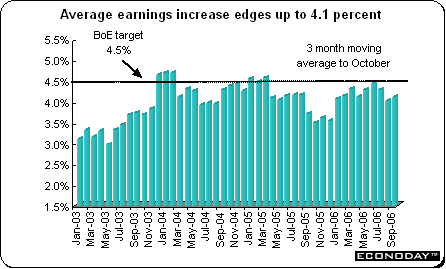
November claimant count unemployment was down 5,700. The unemployment rate remained at 3 percent for the ninth month. The November drop was the largest since January 2005. The ILO unemployment rate for the three months through October was 5.5 percent, down from 5.6 percent in the previous three months. The number of unemployed people was down by 7,000 but increased by 197,000 over the year. The employment rate for people of working age was 74.5 percent, down 0.1 over the quarter and down 0.2 over the year.
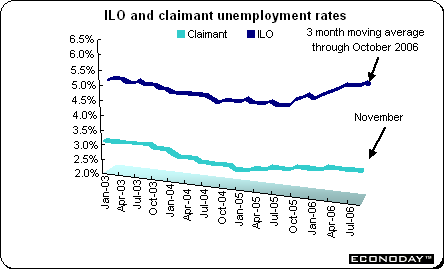
Asia
Japan - November corporate goods price index edged down 0.1 percent but was up 2.7 percent when compared with last year. This was the second consecutive monthly decline. The decline was due to lower gasoline and copper prices that more than offset higher stainless steel prices.
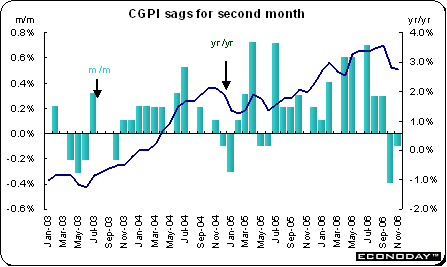
Fourth quarter Tankan survey of large manufacturers' sentiment edged up to 25 from 24 in the previous quarter. Companies plan to increase spending 12.4 percent in the year fiscal year that ends on March 31, 2007. For small manufacturers, sentiment jumped to 10 from 6 in the third quarter. The Tankan, which means short-term economic outlook in Japanese, is the nation's most closely watched gauge of business confidence. It asks 10,000 companies about their outlook for sales, profit, spending and hiring as well as overall sentiment.

October tertiary index, which measures service sector activity, soared by 2.1 percent and was up 1.8 percent when compared with last year. The tertiary index reflects activity in 11 service industries, among which are utilities; transport; telecommunications; wholesale and retail; finance and insurance; real estate; restaurants and hotels; and medical, health care and welfare.
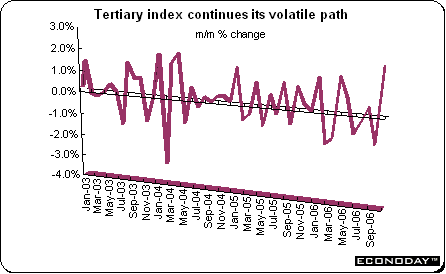
Americas
Canada - October merchandise trade surplus dropped to C$3.8 billion from C$4.5 billion in September. Exports declined 1.7 percent while imports increased by 0.4 percent. The trade surplus with the U.S. dropped to C$6.8 billion from C$7.3 billion the previous month. The surplus has been negatively affects by weaker energy export prices along with sagging automotive and forestry exports. Energy exports were down 11.5 percent, the third consecutive monthly drop.
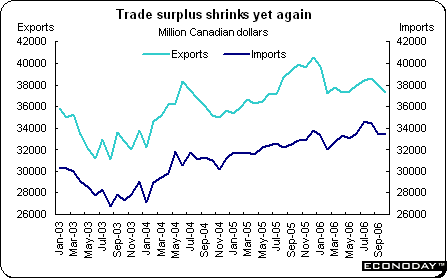
October manufacturing shipments edged down 0.1 percent and were down 5.2 percent when compared with last year. They are at their lowest level in nearly two years, mainly because of falling petroleum prices and a slowdown in the food and transportation equipment sectors. The volume of shipments which take price fluctuations into account were down 0.6 percent, the lowest in nearly four years. Ten of 21 manufacturing industries were down while 10 were up and 1 virtually unchanged in October. Durable goods shipments were up 0.8 percent stemming mainly from the machinery sector. Nondurable goods shipments declined on lower commodity prices, dropping 1.1 percent. Refineries produced at normal levels, but at reduced prices. Consequently, shipments of petroleum and coal products fell 6.2 percent. New orders were up 0.6 percent, thanks to gains in the computer and electronic products industry, the machinery industry, fabricated metals and primary metals. Nearly offsetting these increases were declines in the transportation equipment industry, particularly in the aerospace industry, and a drop in year-end orders for heavy trucks. Unfilled orders increased 0.2 percent. The drop was due mainly to declines in motor vehicles.
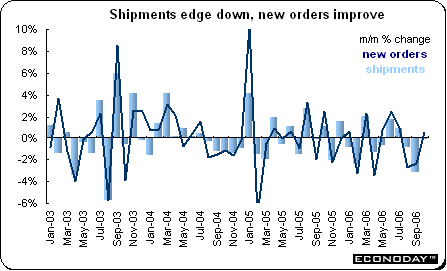
Bottom line
Last week, the Federal Reserve did what was expected and left the fed funds rate at 5.25 percent. And later in the week, investors were rewarded by lower inflation rates in both the U.S. and Europe. In Japan, the all important Tankan survey offset weaker economic data that had been released earlier. The survey showed that sentiment had improved for both large and small manufacturers.
The major event this week is the Bank of Japan meeting. After expecting an increase in December, analysts have backed off and deferred their expectations for an increase into the first quarter of 2007. Overall the data schedule is light for the next two weeks as investors square positions for the year and celebrate the holidays.
Happy holidays from all of us at Econoday!
Looking Ahead: December 18 through December 22, 2006

Looking Ahead: December 25 through December 29, 2006

Anne D Picker is the author of International Indicators and Central Banks, which will be published by John Wiley and Sons in January 2007.

